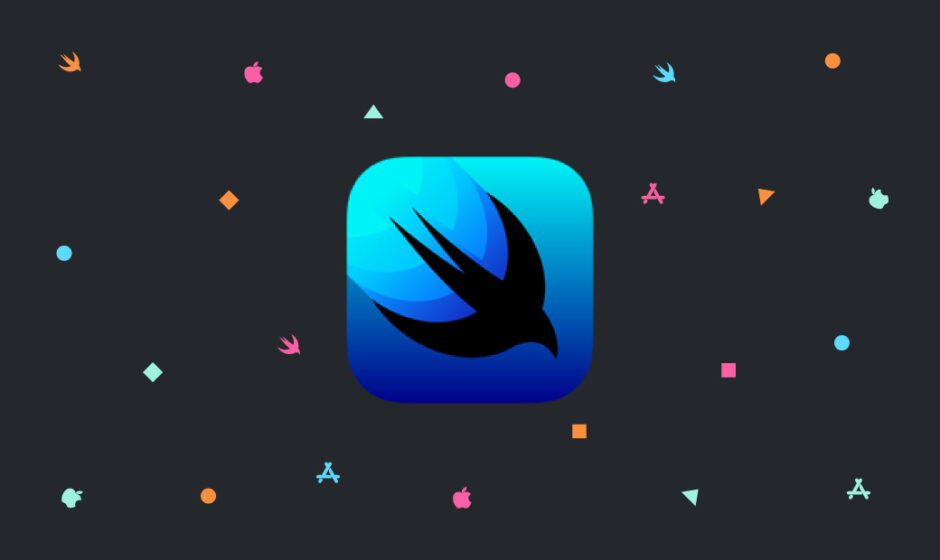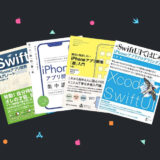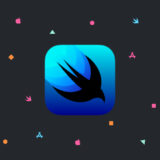この記事では、SwiftUIでListを作る方法について徹底解説していきたいと思います。ListはUIkitで言うUITableViewのことですね。
Contents
Listの実装方法
簡単なリスト
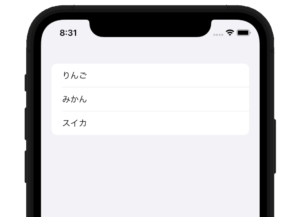
struct ContentView: View {
var body: some View {
List {
Text("りんご")
Text("みかん")
Text("スイカ")
}
}
}
このように、Listの中にTextを並べるだけで、実装できてしまいます。Storyboardを使っていた僕からすると衝撃です。。Textはいくらでも増やせます。
画像とテキスト
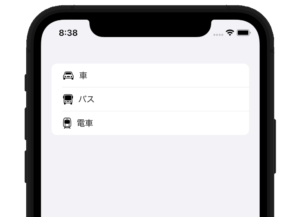
struct ContentView: View {
var body: some View {
List {
HStack {
Image(systemName: "car")
Text("車")
}
HStack {
Image(systemName: "bus")
Text("バス")
}
HStack {
Image(systemName: "tram")
Text("電車")
}
}
}
}
このように、HStackと組み合わせると、画像と文字を表示させることができます。
セクション(グループ)
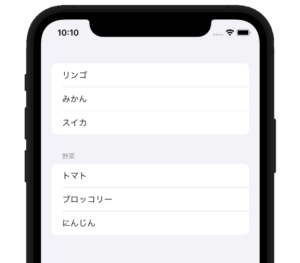
グループ化されたリストのことですね。
struct ContentView: View {
var body: some View {
List {
Section {
Text("リンゴ")
Text("みかん")
Text("スイカ")
}
Section(header: Text("野菜")) {
Text("トマト")
Text("ブロッコリー")
Text("にんじん")
}
}
}
}
このように、Listの中をさらにSectionで囲うとグループにまとめられます。セクションにはheader: で、タイトルをつけることもできます。
ちなみに、headerは、以下のような書き方もできます。
Section {
Text("リンゴ")
Text("みかん")
Text("スイカ")
} header: {
Text("フルーツ")
}
配列をリストにする
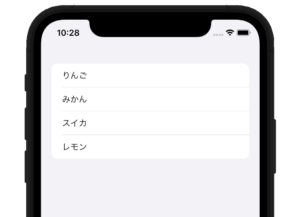
配列をリストに入れるにはForEachを使います。
struct ContentView: View {
let fruits = ["りんご", "みかん", "スイカ", "レモン"]
var body: some View {
List {
ForEach(0 ..< fruits.count) { index in
Text(fruits[index])
}
}
}
}
ちなみに、イレギュラーですが、ForEachを使わなくてもリストを作ることができます。
struct ContentView: View {
let fruits = ["りんご", "みかん", "スイカ", "レモン"]
var body: some View {
List(fruits, id: \.self) { fruit in
Text(fruit)
}
}
}
Structの配列をリストにする
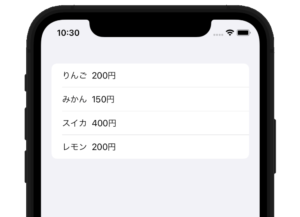
Structの配列を使う場合は、このように書きます。一つのセルに複数の情報を入れる場合は、こちらの実装の方が良さそうですね。
struct Fruits: Identifiable {
var id: Int
var name: String
let price: Int
}
struct ContentView: View {
let fruitsList = [
Fruits(id: 0, name: "りんご", price: 200),
Fruits(id: 1, name: "みかん", price: 150),
Fruits(id: 2, name: "スイカ", price: 400),
Fruits(id: 3, name: "レモン", price: 200)
]
var body: some View {
List(fruitsList) { fruitsList in
HStack {
Text(fruitsList.name)
Text("\(fruitsList.price)円")
}
}
}
}
セルのタップ判定
struct ContentView: View {
var body: some View {
List {
Text("りんご")
.onTapGesture {
print("りんごがタップされた。")
}
Text("みかん")
Text("スイカ")
}
}
}
そのセルに、.onTapGestureをつけることでタップ判定を取得することができます。これで、「りんご」をタップすればprint文が実行されます。
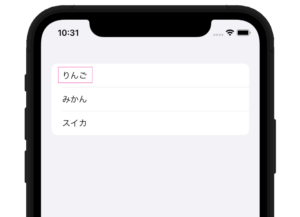
ただ、これだと、タップ領域が文字のところ(ピンクで囲ったところ)しかありません。
そのため、以下のように記述すると、タップ領域がセル全体になります。これだとセルのどこをタップしてもprint文が実行されます。
struct ContentView: View {
var body: some View {
List {
HStack {
Text("りんご")
Spacer()
}
.contentShape(Rectangle())
.onTapGesture {
print("りんごがタップされた。")
}
Text("みかん")
Text("スイカ")
}
}
}
タップ時に画面遷移
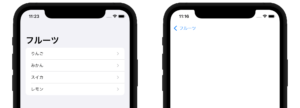
セルをタップしたときに、画面遷移させるという場面が多いと思いますが、以下のコードで簡単に実装できます。
struct ContentView: View {
let fruits = ["りんご", "みかん", "スイカ", "レモン"]
var body: some View {
NavigationView {
List {
ForEach(0 ..< fruits.count) { index in
NavigationLink(destination: Text(fruits[index])) {
Text(fruits[index])
}
}
}.navigationBarTitle("フルーツ")
}
}
}
NavigationViewで全体を囲い、セルの内容をNavigationLinkで囲うと、これだけで画面遷移ができちゃいます。あと、セルの左側にシェブロンマーク(>)が付きます。
ちなみに、NavigationLinkを使わずに、このシェブロンマークを表示させるには、以下のように書きます。普通に無理矢理というか、、、、画像をつけてるだけです。
struct ContentView: View {
let fruits = ["りんご", "みかん", "スイカ", "レモン"]
var body: some View {
List {
ForEach(0 ..< fruits.count) { index in
HStack {
Text(fruits[index])
Image(systemName: "chevron.right")
.font(Font.system(size: 14, weight: .semibold))
.foregroundColor(.secondary)
.opacity(0.5)
}
}
}
}
}
スワイプアクション

スワイプのアクションは以下のように記述します。
struct ContentView: View {
let fruits = ["りんご", "みかん", "スイカ", "レモン"]
var body: some View {
NavigationView {
List {
ForEach(0 ..< fruits.count) { index in
Text(fruits[index])
.swipeActions(edge: .trailing) {
Button(role: .destructive) {
// 処理
} label: {
Image(systemName: "trash.fill")
}
}
.swipeActions(edge: .leading) {
Button {
// 処理
} label: {
Image(systemName: "flag.fill")
}.tint(.orange)
}
}
}
}
}
}
.swipeActionsでスワイプアクションをつけることできます。
edge: は位置を決めることができて、.trailingが右で.leadingが左です。
label: {の中に、画像やテキストを入れます。その後に、.tint(.orange)で色を変えることができます。
こちらは、iOS15から使えるモディファイアとなっております。そのため、対象OSを14.0(デフォルト)にしているとエラーになります。対象OSを15.0にするか、if #available(iOS 15.0, *) {で囲わなければなりません。
リストの色を変更する
セルの色を変更する

struct ContentView: View {
var body: some View {
List {
Text("りんご")
.listRowBackground(Color.red)
Text("みかん")
.listRowBackground(Color.blue)
Text("スイカ")
.listRowBackground(Color.green)
}
}
}
背景色を変更する
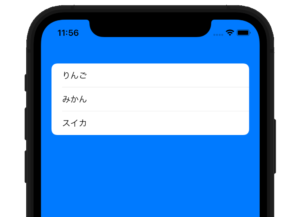
struct ContentView: View {
var body: some View {
List {
Text("りんご")
Text("みかん")
Text("スイカ")
}
.scrollContentBackground(.hidden)
.background(Color.blue)
}
}
この方法は、iOS16で使えるようになりました。
ちなみに、iOS16以前では、以下のような指定をしていました。
struct ContentView: View {
var body: some View {
List {
Text("りんご")
Text("みかん")
Text("スイカ")
}
.onAppear {
UITableView.appearance().backgroundColor = UIColor.blue
}
}
}
SwiftUIでは、背景色を変更できないので、UIKitを使って変更させています。
リストの表示を変更する
リストの線を削除する
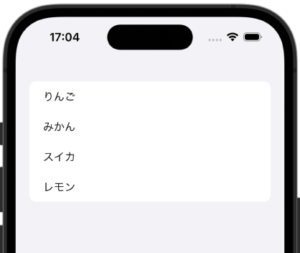
struct ContentView: View {
let fruits = ["りんご", "みかん", "スイカ", "レモン"]
var body: some View {
List {
ForEach(0 ..< fruits.count, id: \.self) { index in
Text(fruits[index])
}
.listRowSeparator(.hidden)
}
}
}
リストのスタイルを変更する
リストにはいくつかのスタイルがあります。上記のリストは全てiOS14以降のデフォルトのスタイルになっています。
以下のコードのように、.listStyle(DefaultListStyle())というふうにスタイルを決められるのですが、何も書かない場合・DefaultListStyle()を指定した場合は、OSのバージョンによってスタイルが決められます。
struct ContentView: View {
var body: some View {
List {
Text("りんご")
Text("みかん")
Text("スイカ")
}
.listStyle(DefaultListStyle())
}
}
PlainListStyle()
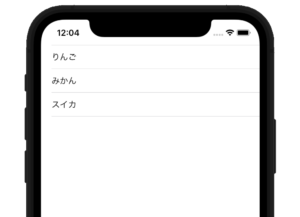
これは、ちょっと前のリストのスタイルですね。iOS13までこのリストでした。
.listStyle(PlainListStyle())
GroupedListStyle()
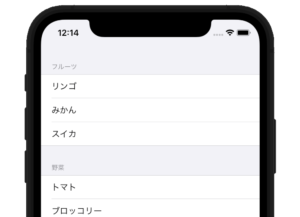
こちらは、背景色(セル部分以外)がグレーになるスタイルですね。
.listStyle(GroupedListStyle())
InsetListStyle()
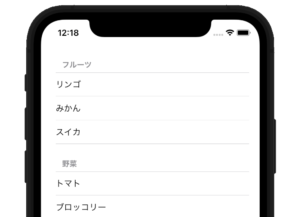
こちらは、左右に余白ができるスタイルになります。iOS14で追加されました。
.listStyle(InsetListStyle())
InsetGroupedListStyle()

こちらは、iOS14以降のデフォルトスタイルですね。
.listStyle(InsetGroupedListStyle())
SidebarListStyle()
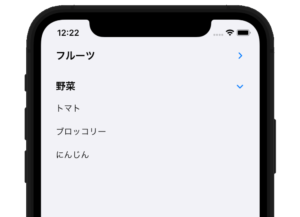
こちらは、右側のボタンを押すとリストが表示非表示の切り替えができます。iOS14で追加されました。
.listStyle(SidebarListStyle())
最後にまとめると、以下のスタイルがあります。
| スタイル | 使用可能OS | 説明 |
|---|---|---|
| DefaultListStyle() | – | OSにあったスタイルが適応される |
| PlainListStyle() | – | iOS14以前のデフォルトスタイル。非常にシンプル |
| GroupedListStyle() | – | セル以外グレー色になる。 |
| InsetListStyle() | iOS14〜 | 左右に余白ができる。背景色は白。 |
| InsetGroupedListStyle() | iOS14〜 | iOS14以降のデフォルトのスタイル。 |
| SidebarListStyle() | iOS14〜 | セクションごとに表示非表示ができるスタイル。 |
参考文献
